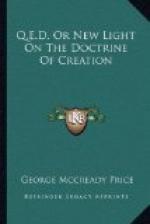[Footnote 34: “History of Geology,” p. 59.]
Werner had found the granites, limestones, sandstones, schists, etc., occurring in a certain relative order in his native country; and he drew the very remarkable conclusion that this was the normal order in which these various rocks would invariably be found in all parts of the world, on the theory that this was the order in which these different rocks had been formed in the beginning, great layers of these different rocks having originally been spread completely around the globe one outside another like the coats of an onion. With this as a major premise, it is not surprising that he and his enthusiastic disciples “were as certain of the origin and sequence of the rocks as if they had been present at the formation of the earth’s crust."[35]
[Footnote 35: A. Geikie, “Founders of Geology,” p. 112.]
The amusement with which this onion-coat theory is now regarded is hardly appropriate in view of its universal vogue among geologists about the beginning of the nineteenth century, and in view of the further fact that a very similar and only slightly modified substitute theory has been universally taught for three-quarters of a century and still prevails. The modern form of the theory substitutes onion-coats of fossiliferous rocks for onion-coats of mineral and lithological characters; and a brief consideration of this theory is now in order.
About the time that various geologists here and there were finding rocks in positions that could not be explained in terms of Werner’s theory, William Smith (1769-1839) in England and the great Baron Cuvier (1769-1832) in France found characteristic fossils occurring in various strata; and under their teachings it was not long before the fossils were considered the best guide in determining the relative sequence of the rocks. The familiar idea of world-enveloping strata as representing successive ages was not discarded; but instead of Werner’s successive ages of limestone making, sandstone making, etc., these new investigators taught that there were successive ages of invertebrates, fishes, reptiles, and mammals, these creatures having registered their existence in rocky strata which thus by hypothesis completely encircled the globe one outside another.
It is true that early in the nineteenth century Sir Charles Lyell and others tried to disclaim this absurd and unscientific inheritance from Werner’s onion-coats; but modern geology has never yet got rid of its essential and its chief characteristic idea, for all our text-books still speak of various successive ages when only certain types of life prevailed all over the globe. Hence it is that Herbert Spencer caustically remarks: “Though the onion-coat hypothesis is dead, its spirit is traceable, under a transcendental form, even in the conclusions of its antagonists."[36] Hence it is that Whewell, in his “History of the Inductive




